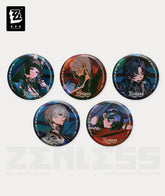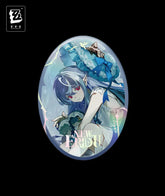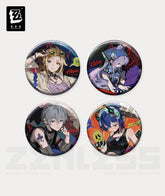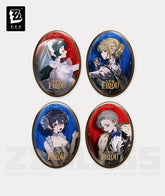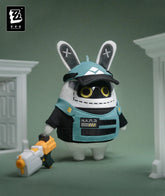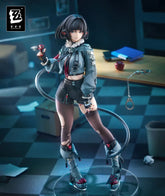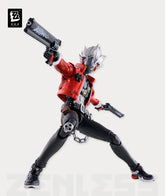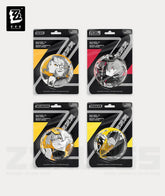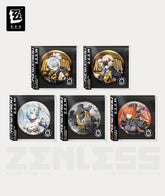ZZZ Hugo Analysis: How to Break the Stereotypical Phantom Thief Persona?
With charismatic flair, he enters the scene, seizes the core, delivers an iconic line, then vanishes into darkness-utterly classic! The phrase "Phantom Thief" practically crashes into our minds. Even without diving deep into the lore or following subsequent events, we instantly grasp the "Phantom Thief" motif. This is a triumph of character branding, yet merely conveying the Phantom Thief archetype risks falling into cliché. Instead of dissecting this predictable trope, let's explore how Hugo in Zenless Zone Zero's Version 1.7 transcends the stereotypical Phantom Thief persona.

1. Zenless Zone Zero Hugo's Core Persona: Phantom Thief
To form an initial impression of Hugo, let's first deconstruct his core persona:
1.1 Danger/Mystery
Dangerous and mysterious-this is our first impression of Hugo. The early storyline offers limited exposure to his inner world, leaving players unable to intuitively discern his motivations. What unfolds narratively are only his external actions: proactively facilitating connections, providing auction invitations, and so on. Yet, human nature dictates that the more enigmatic and perilous a character appears, the more it fuels our curiosity and desire to unravel their secrets.

1.2 High Intelligence/High Emotional Intelligence
As the story progresses, we observe that Hugo embodies the high intellect and emotional acuity essential to the Phantom Thief archetype. He navigates elite circles, interacts with high-society figures, and maintains a flawless intelligence network. His briefcase perpetually holds an arsenal of weapons and tools-not just for combat, but also for vanishing without a trace post-mission (see his staged death at the end of Version 1.6).
Hugo's briefcase itself is a disguised scythe capable of transforming and long-range shooting. Combined with his formidable combat prowess, he could easily overpower most obstacles. Yet the writers understand: players aren't drawn to Phantom Thieves for brute-force dominance, but for high-stakes intellectual duels and psychological mind games.

1.3 Behavioral Motives as a Phantom Thief & the "Heist Manifesto"
The distinction between a Phantom Thief and a common thief lies in motivation: Phantom Thieves aren't driven by the thrill of crime. In the story, Hugo "steals" during aristocratic auctions to weaken the Ravenlock family and Tops Syndicate.
Beyond the allure of subverting established order, Hugo naturally embraces the "heist manifesto" trope. Like all iconic Phantom Thieves, he issues public crime notices-focusing attention while declaring war on the powers-that-be: "Even if I reveal the time and location, this remains an improvised performance."
2. Hugo's Motivations as a Phantom Thief in Zenless Zone Zero
Building on the act of "robbing the rich to aid the poor," let us delve into Hugo's inner motivations:
2.1 Early-Stage Motivations
Hugo showed no concern for self-redemption. His motivations were entirely external-he sought to balance the unfairness of fate by stealing from the wealthy to help the disadvantaged. He executed thefts flamboyantly, then redistributed the spoils to those deemed deserving. In this aspect, Hugo shares similarities with the "Righteous Thief" archetype: both despise power hierarchies like family syndicates, primarily target valuables such as money and jewels, emphasize the redistribution of stolen goods, yet adhere to a moral code of "honor among thieves."
For example, Robin Hood, a classic Righteous Thief, embodies this. Comparing Hugo to such figures, his persona aligns more with a Righteous Thief than a Phantom Thief.
2.2 Late-Stage Motivations
After experiencing the full narrative arc, Hugo reconciles with his inner darkness, clarifies his mission, and overcomes his psychological struggles. This internal character journey elevates him beyond the stereotypical molds of both Phantom Thief and Righteous Thief. Phantom Thieves typically fixate on self-redemption, relying heavily on "theft" to validate their existence, while Righteous Thieves derive purpose from resisting oppression and redistributing wealth. Hugo stands as an exception, blending motivations from both archetypes. His core allure lies in his eternal struggle against his inherited bloodline. As a member of the Ravenlock family, he must battle the inherent deceit and malice in his veins until achieving final redemption.
Beyond innovative character motivations, Hugo's design breaks stereotypes. High-frequency, rationalized thefts are usually central to the Phantom Thief archetype. Yet Hugo's pivotal moment bypasses the act of theft itself. Instead, it stages a "mutual destruction" scenario-a meticulously faked death in Version 1.6 injects suspense spanning Versions 1.6 to 1.7, culminating in a dramatic narrative reversal using pre-planted clues by the end of Version 1.7.

Additionally, Phantom Thieves often isolate themselves, but Version 1.7 crafts a "betrayal" plot between Hugo and Lycaon. Former allies in the Mockingbird Faction now stand on opposing sides, initially clashing violently but ultimately executing a flawless performance. Such plot-driven conflicts are rare in Phantom Thief stories (which prioritize individualism) but common in Righteous Thief narratives. Introducing a betrayal rooted in conflicting ideals or uneven spoils balances the narrative tone. In Hugo's story, Lycaon and Vvian serve as mirrored reflections of his character. Through their respective attitudes and actions toward fate, they illuminate Hugo's central theme: "Ambition is an innate gift; good and evil exist within all." The trio's divergent responses to this truth define their paths.
2.3 "Both a hero and the dragon, sworn rivals yet closest allies."
Staying true to Zenless Zone Zero's signature high-impact character writing, Hugo is no exception. His exceptional intellect and emotional acuity stem from childhood hardships-deprived of care, witnessing Serana's death-while drawing malice from the abyss birthed an inner dragon. Yet by the story's end, he transcends the classic "hero slays dragon" trope. Here, the hero and dragon reconcile, for "only when pain is seen and accepted can it fade."

Another narrative crescendo emerges from his bond with Lycaon. Believing Hugo violated the Mockingbird Faction's ideals by killing his father, Lycaon severed ties. But after the Shenggui Incident in Version 1.7, they resolve their grievances and clear misunderstandings. Their brief reunion ends with diverging paths: Lycaon realizes "claws cannot excise corruption," while Hugo chooses power and systemic upheaval-infiltrating the rules only to dismantle them.
3. Hugo's Visual Design in Zenless Zone Zero
How are characterization and gameplay mechanics interconnected? Summarizing Hugo's persona in one sentence: The treacherous Ravenlock bloodline is his curse, but like the flowers that bloom in the abyss are always soaked in malice, just as a poisoned tree cannot bear safe fruit. Yet all fruits fall. Thus, he shattered himself into a rain of fragments-each dewdrop reflecting a new dawn. While Hugo is meticulously built around the Phantom Thief archetype, his visual design truly embodies the character's essence.
In combat animations, his movements exude elegant paired with savage impact. His briefcase, seemingly a storage container, transforms into a versatile weapon capable of slashing with ice damage or executing charged shots. Beyond the elegance lies a vampiric aura of decadence and madness. When charging attacks, he casually rests the scythe on his shoulder, lowers his center of gravity with one arm dangling-radiating utter nonchalance. His diverse combat styles (martial arts, daggers, scythe) rank among the most varied currently, mirroring his ruthless "ends justify means" ethos.

Hugo's attire aligns with classic vampire imagery: silver hair, a slender frame, and a tailored suit radiate aristocratic rigor. Yet contrasting elements emerge-he idly flips coins and wears sleeves half-draped-infusing his polished look with rebellious flair.
4. Zenless Zone Zero Hugo: Character Concept
After exploring his animations and visual design, let's delve into Hugo's character concept to decode his gameplay mechanics. For Hugo: "The treacherous Ravenlock bloodline is his curse, but like the flowers that bloom in the abyss are always soaked in malice, just as a poisoned tree cannot bear safe fruit. Yet all fruits fall. Thus, he shattered himself into a rain of fragments-each dewdrop reflecting a new dawn." Once his mission is defined, his mechanics gain narrative purpose.Hugo's combat blends gentility with vampiric ferocity. The game's CRIT and Stun systems aren't arbitrary-characters with innate CRIT-boosting effects symbolize aggression through CRIT. Consider the state name "Dark Abyss Reverb": isn't this his childhood struggle against the family's cursed bloodline?

Another example: the synergy between trigger efficiency and high CRIT rates mirrors a sniper's lethal precision. Though Hugo's kit seems complex, focus on this core: as a DPS-focused agent, damage multipliers and early-phase mechanics dominate. Initially, players worried about overlap with Ellen in this role, but In actual combat reveals stark differences. Hugo incentivizes Daze burst rotations-prioritizing rapid Stun triggers and damage spikes during brief vulnerability windows. Ending enemy Daze time early forces sustained aggression, turning high-difficulty battles into self-imposed challenges.
In the end, he is the Phantom Thief of elegance and composure; the Mockingbird Faction operative navigating moral gray zones; the magician who faked death to deceive all of New Eridu; the test subject enduring drug trials with desperate resolve in cutscenes; and, of course, the inner "child" that fuels Hugo's journey. These facets collectively transcend the stereotypical Phantom Thief trope, embodying his dual allure as both hero and dragon.
That concludes all breakthroughs in Hugo's design. Will this unconventional "Phantom Thief" captivate you? Stay tuned for more new character insights and Zenless Zone Zero merchandises!
Zenless Zone Zero Official Merchandise
- $286.90
- $286.90
- Unit price
- / per
- $129.90
- $129.90
- Unit price
- / per
- $99.90
- $99.90
- Unit price
- / per
- From $14.90
- From $14.90
- Unit price
- / per
- From $14.90
- From $14.90
- Unit price
- / per
- From $14.90
- From $14.90
- Unit price
- / per
- $29.90
- $29.90
- Unit price
- / per
- From $14.90
- From $14.90
- Unit price
- / per
- From $14.90
- From $14.90
- Unit price
- / per
- From $9.90
- From $9.90
- Unit price
- / per
- $29.90
- $29.90
- Unit price
- / per
- $29.90
- $29.90
- Unit price
- / per
- $316.90
- $316.90
- Unit price
- / per
- $139.90
$159.90- $139.90
- Unit price
- / per
- $29.90
- $29.90
- Unit price
- / per
- $49.90
- $49.90
- Unit price
- / per
- From $29.90
- From $29.90
- Unit price
- / per
- $35.90
- $35.90
- Unit price
- / per
- $14.90
- $14.90
- Unit price
- / per
- $14.90
- $14.90
- Unit price
- / per


















